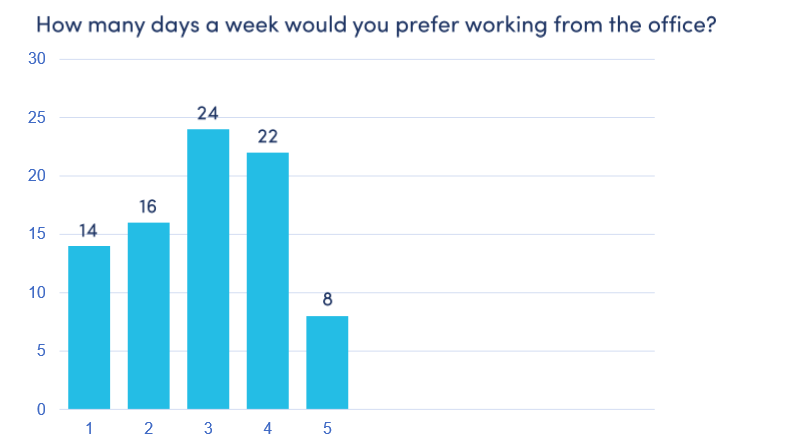Since the outbreak of Covid-19, the term “remote work” has acquired an altogether different meaning. Until now, being able to work remotely or work from home has been more of an extra – something that flexible employers could offer as a perk to their potential workers.
The coronavirus outbreak has fast-forwarded us to a new reality. One where allowing remote work is rather a survival strategy for many companies.
Let’s face it – until now many business owners and managers were skeptical about the work from home (WFH) option because of a common assumption that employees were less productive and less efficient at home. The Covid-19 crisis has proved many of us wrong and showed us that it’s possible to be productive outside the office.
We at TWINO see our future in the hybrid work environment – one where employees split their workweek between their home and the office. We see it as a win-win for the staff and the management, and we are considering moving to this work setup permanently. This article shows how we came to that conclusion and how we plan to implement it.
TWINO employees are happy and productive while working from home
TWINO moved the team to remote work immediately after the emergency state was announced in each country. First country to announce an emergency state was Poland. For example, in Russia, TWINO was the first lending fintech company to offer remote work possibility to our employees.
After a month in this new work reality, we decided to measure the satisfaction of TWINO employees and to ask them how this setup has affected their efficiency and well being.
First, we asked them how they generally feel during the work from home period and how they would rate their work efficiency during this time.
Here are the results that came back:
The graphs show that employees are generally satisfied with the WFH model (average rating of 7.9 out of 10) and that they feel efficient while working from home (average rating of 8.6 out of 10).
The trend is apparent:
The best future office will be a hybrid one – with some office days and some WFH days every week.
We asked our employees how many days per week they would prefer working from the office.

The survey answers are diverse, but most TWINO employees would prefer to work two, three or four days from the office and the rest from home. These answers indicate that the split between office days and WFH days should be close to 50/50.
A smaller, but more modern and collaborative office space
So, in the hybrid model, employees will generally spend much less time in the office than they did before. What changes will this bring to our physical office space?
First, TWINO’s new office space will have to be smaller but more modern and interactive. Because co-workers will meet each other less frequently, we’d like to add value to those encounters.
Here’s how:
- The new office will be designed as a modern and comfortable open space
- It would have plenty of private and communal areas for various social interactions
- It should also be transformable – an open office during the day, and a space for community events and meetups in the evening
It’s not a secret that open offices have been criticized for being unproductive and uncomfortable for employees. But in the hybrid model, this downside will be less of a concern. Because if the employee needs some quiet time to focus, they will be able to switch to working from home at any time.
The open office layout will also benefit cross-functional collaboration between different teams, as various departments will be stationed in the same premises. The office days will be rotated among different teams to achieve the biggest possible cross-functional mix. For example, one day of the week IT and finance teams will be present in the office together, but then another day or week IT will have an office day together with Data Science and Risk management teams.
Time management and leadership challenges
The new hybrid office model is likely going to be a trial for our leadership, People and communication team. Managers will have to be able to set very precise and detailed tasks and find effective solutions for daily communication within and across teams.
During the current crisis, the majority of TWINO teams are doing morning check-in and evening check-out calls every day. In the long run, we’d also like to be able to respect and adjust to each employee’s individual daily rhythm (morning person vs. evening person) and productivity peaks.
To keep a high productivity standard, all employees will be asked to use DeskTime time management software. This tool measures individual use of productive or unproductive apps for each employee and will help to make sure that our productivity standards are met.
The new face of onboarding, team-building, and internal communication
Like many businesses, TWINO will have to rethink how we onboard our new employees. We are planning to require new employees to spend their first month with us working exclusively from the office. After this “trial period,” the employee will be welcome to work from home some days of the week, just like all the other employees.
Special team meeting days will be organized at the office or outside to maintain real-life communication among teammates. Workations will become standard practice and will serve as team-building events.
In our team satisfaction survey, we also asked our employees how they would rate TWINO’s virtual communication during the remote work period.
This chart shows that our employees are generally happy about TWINO’s virtual communication (an average rating of 8.16 out of 10). This proves TWINO’s policy that “there can never be too much communication during a crisis” to be effective.
TWINO uses many internal communication channels, and in some of them the intensity of communication has doubled since the start of remote work. For example, TWINO teams use Zoom app for online meetings, kitchen socializing events, and live streams from the company management.
As for informal events, there is a “Work from home” Facebook group where employees can share their news or jokes about the current situation. Soon TWINO will launch its first online brain games with party elements. Possibly there will be a quiz or a treasure hunt challenge that will urge employees to spend time outside.
However, offline communication channels will have to be adjusted to the new office reality. For example, until now TWINO used in-office TV screens for keeping the team updated with company news and encouraging positive vibes.
With the hybrid model in place, we might have to switch to something as “old school” as an internal radio station. Corporate radio is a communication channel that could be heard and used by everyone – those employees who are working from home as well as those who are in the office that day.
A different set of employee perks
With the new hybrid office model, not only will employee benefits change significantly but so will the TWINO company culture.
For example, we used to order fresh fruit and healthy snacks for the office. This isn’t simply a perk, it’s a part of company culture – a way to promote a healthy lifestyle and to take care of our staff. In the WFH or hybrid office model, such benefits lose their importance, since employees spend much less time in the physical office space.
At TWINO, we see that our people & leadership teams will have to work on adjusting our employee benefits packages according to the hybrid work setup. Possibly, the budget for things like fruit in the office will have to be moved towards setting up ergonomic workspaces for employees at home (like office chairs or a set budget for them to use to improve their home offices).
Conclusion
The current crisis has affected thousands of businesses around the world, and even relatively flexible and open-minded companies have to rethink the way they use their offices.
We at TWINO see this as an opportunity for introducing a more balanced work setup for our employees. Other benefits of the hybrid office include a significant reduction in costs like rent, parking, furniture, etc. Having fewer people in the office at once will also be a sound tactic in terms of preventing the potential spreading of viruses.
We are excited about switching to the hybrid work setup. We feel that this change will mean much more than simply switching to a different working pattern. We see it as a global relaunch of TWINO’s internal culture with a focus on entrepreneurship, innovation and trendsetter mindset.
